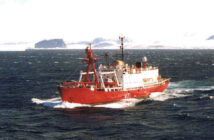What We Can Learn From the First Manned Mission to the Moon
My clearest early memory was Christmas Eve 50 years ago during the extraordinary Apollo 8 mission.
I was sitting on the floor, near my baby brother and our piano stool, watching our black and white Zenith TV.
We were among a third of the planet — then 3.5 billion people — riveted by the reality that human beings were circling the Moon. The collective memory of that event, of a blurry Earth rising over the Moon as the crew read from Genesis was one of history’s most poignant and iconic moments.
As was the photograph that Bill Anders snapped of the Earthrise, a single image that put into perspective how tiny our blue planet is against the vast blackness of space and the barren, pockmarked starkness of our Moon.
And from space, the Cold War and the brutal fighting in Vietnam, the struggle for civil rights, the tragic killings of Martin Luther King and Bobby Kennedy or rampant pollution were invisible. Ironically, we literally had to go to the moon to see how lucky we were on the good Earth — and how important is was to protect it.
The mission itself was a towering achievement propelled by a fear that the Soviets were in the lead in the race that John Kennedy had started in 1961.
Intelligence that the Russians were preparing their own mission turned what was to have been a high earth-orbit mission into the first moonshot. If America couldn’t land a man on the moon before the Soviets, it would at least be first to orbit it.
To make that happen, NASA worked with methodical precision and speed to speed into service the Saturn V booster — which had only completed two test flights — a modified Apollo spacecraft, new deep space tracking and communications networks, and train the three-man crew for the longest human voyage in history.
It was a mission of firsts. The first time humans had left earth orbit, the first to head to the moon a quarter million miles away and back, the first to see the dark side of the moon and the first to orbit it — 10 times — and the first humans to thread a navigational needle to return safely to earth. They set a speed record to boot.
The commander of the mission was Frank Borman, one of the giants of the American space program. After the deadly 1967 fire that killed Gus Grissom, Ed White and Roger Chafee, Borman was instrumental in reengineering the program and getting it back on track.
Teamed with his Gemini VII shipmate, Jim Lovell, two of the Apollo 8 crew were the world’s most experienced astronauts. They were joined by rookie Bill Anders.
To the world, the mission went flawlessly, although Borman became violently ill in Earth orbit, something the crew kept from Mission Control lest the mission be scrapped. they successfully circled the moon 10 times, making valuable observations to blaze the trail for the eight moon missions to follow.
There are myriad lessons from this incredible mission.
First, NASA was able to shift gears on the fly to undertake the most complex voyage of exploration to date while carefully balancing risk. There is much that can be learned from the leadership and organizational model that delegated authority and moved quickly to get big things done.
Second, the mission was among a myriad of experiences that the nation shared together. Some, like Apollo 8 — and the Moon program at the time — brought together a divided nation. Others, like the King assassination, literally tore the country apart so badly that neighborhoods destroyed in 1968 weren’t rebuilt until just a few years ago.
In the 1960s, even NYC only had a handful of TV stations, so when something big happened, everyone tuned in thereby connecting us to major events. The imagery was seared into our collective memory.
The proliferation of news sources and new technologies allows us all to watch what we want when we want it. Then, the entire nation tuned in at 6:30 pm to watch the evening news. A nation needs collective moments that bring us all together while at the same time ensuring that we all have a common understanding of events, facts and history.
Today, the ability to select news sources — some of dubious authenticity — ensures chunks of the population often reject objective reality in favor of preferred and often warped interpretations of real events.
Absent objective truth and a common understanding of events, facts and their implications is dangerous for the future of the nation. When citizens don’t have a uniform understanding of reality, their ability to make informed decisions about major questions — whether the wars in Syria and Afghanistan, how to counter China and Russia or address climate change — are impossible.




